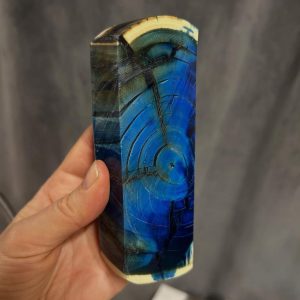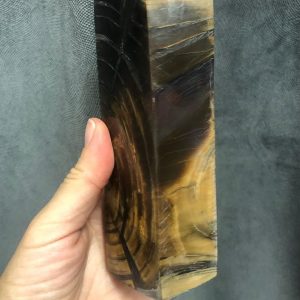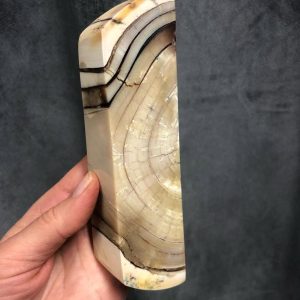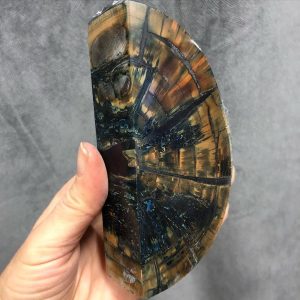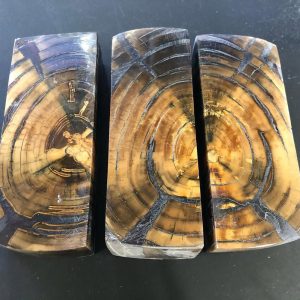Mammoth Tusks
Mammoth tusks preserved in Arctic permafrost for over 10,000 years offer exceptional material for artisans, collectors, and investors seeking premium prehistoric ivory. Our professionally stabilized tusks undergo advanced resin treatment under vacuum pressure, transforming naturally fragile fossils into durable, workable material ideal for knife making, luxury crafts, and high-end applications. From complete display specimens to precision-cut scales and blocks, each piece combines Ice Age authenticity with modern functionality—legally sourced, expertly processed, ready for your creative vision.
Showing 1–12 of 25 results
Why Professional Stabilization Transforms Raw Mammoth Tusks
Freshly recovered mammoth ivory faces significant challenges. After millennia buried in frozen ground, tusks emerge saturated with moisture, riddled with micro-fractures, and structurally compromised from cycles of freezing and thawing. Natural drying requires months or years under controlled conditions, yet even properly cured material remains susceptible to cracking, warping, and dimensional changes when exposed to humidity fluctuations. This inherent instability makes raw mammoth ivory problematic for demanding applications where reliability matters.
Professional stabilization solves these fundamental issues through sophisticated resin impregnation. The process begins with complete moisture removal using industrial vacuum chambers. Once thoroughly dried, tusks undergo pressure treatment forcing specialized resins deep into the cellular structure. This transformation increases material density dramatically while preserving natural grain patterns and coloration. The result delivers all the aesthetic beauty collectors prize with none of the structural vulnerabilities plaguing untreated specimens. Stabilized mammoth ivory machines predictably, accepts adhesives reliably, and maintains dimensional stability across varying environmental conditions.
Selecting Quality Mammoth Tusks for Different Applications
Understanding tusk anatomy helps match materials to intended uses. Complete tusks suitable for display range from compact 2-3 foot specimens perfect for home collections to museum-grade giants exceeding 10 feet commanding serious investment capital. Display tusks should exhibit minimal cracking, rich natural coloration, and attractive curvature showcasing the species’ iconic spiral form. Siberian specimens often display warm browns and creams, while North Sea recoveries sometimes feature striking blue-gray mineral staining from marine sediments.
Craftsmen seeking working material prioritize different characteristics. Inner core ivory cut from tusk centers provides uniform cream-white material ideal for knife scales, pen blanks, and jewelry components. The distinctive grain pattern—Schreger lines visible in cross-section—authenticates genuine mammoth ivory while creating subtle visual texture distinguishing finished pieces from synthetic alternatives. Outer bark sections deliver dramatic color variations and textured surfaces valued for decorative applications where visual impact outweighs uniformity requirements.
Size specifications matter significantly for project planning. Knife handle scales typically require pieces 4-6 inches long, 1-1.5 inches wide, and 1/4 inch thick. Pistol grip blanks need larger dimensions accommodating final shaping—roughly 5x2x1 inches minimum. Pen turners work with compact squares around 3/4 inch across and 5-6 inches long. Having precise measurements before purchase prevents material waste and ensures adequate working stock for your specific applications.
Legal Status and Ethical Sourcing Considerations
Mammoth ivory enjoys completely legal status worldwide, providing guilt-free alternatives to restricted elephant ivory. International regulations under CITES (Convention on International Trade in Endangered Species) specifically exempt extinct species, allowing unrestricted commerce across borders. This legal clarity makes mammoth material accessible for craftsmen, collectors, and commercial applications without complicated permitting or documentation requirements affecting contemporary ivory trade.
Ethical sourcing still demands attention. Reputable dealers provide clear provenance documenting recovery locations and dates. Siberian tusks should include Russian export documentation. Alaskan specimens often come with collection permits from private land or documented commercial recovery operations. North Sea materials typically originate from fishing bycatch or controlled dredging activities in international waters. This transparency distinguishes legitimate operations from questionable suppliers making unsupportable authenticity claims.
Investment Potential and Market Dynamics
Mammoth tusk values have appreciated substantially as supply constraints meet growing collector demand. Complete museum-quality tusks suitable for luxury interior design command price high for modest specimens and increases for exceptional examples exceeding 8 feet with pristine preservation. Matched tusk pairs representing single animals occasionally reach six-figure valuations at major natural history auctions. These premium specimens attract corporate buyers, private museums, and high-net-worth individuals seeking statement pieces combining aesthetic impact with tangible scarcity.
Working material markets remain robust as artisan demand continues expanding. Stabilized scales, blocks, and blanks retail at sustainable price points making mammoth ivory accessible to professional craftsmen and serious hobbyists. Limited supply—new recovery depends on brief summer thaw periods in remote Arctic regions—supports stable pricing resistant to market volatility affecting other exotic materials. Quality stabilized ivory represents sound investment for workshops maintaining material inventories, as availability cannot scale to meet increasing global interest in premium natural materials.
Care and Storage of Stabilized Material
Properly stabilized mammoth ivory requires minimal special handling compared to natural specimens. The resin treatment seals material against moisture absorption, eliminating concerns about humidity-related dimensional changes. Store pieces in normal workshop environments without specialized climate control. Avoid prolonged direct sunlight which can gradually fade surface colors over years of exposure, though this affects display pieces more than working stock used shortly after purchase.
Machining stabilized ivory proceeds using standard woodworking and bone-working techniques. Carbide tooling delivers longest life, though HSS tools perform adequately. Sharp edges prevent overheating—dull tools generate excessive friction potentially scorching material. Light cutting passes work better than aggressive material removal. Standard adhesives including epoxy, cyanoacrylate, and polyurethane bond reliably to properly prepared surfaces. Finishing follows conventional sanding progressions from coarse to fine grits, concluding with buffing compounds producing remarkable luster highlighting natural grain patterns.
Frequently Asked Questions About Mammoth Tusks
What is the difference between stabilized and natural mammoth tusks? Stabilized tusks undergo professional resin impregnation increasing density, durability, and moisture resistance—essential for working applications like knife handles. Natural tusks preserve original character but remain vulnerable to cracking and dimensional changes. Choose stabilized material for functional projects, natural specimens for display collections.
How much do authentic mammoth tusks cost? Prices vary dramatically by size, quality, and form. Small working pieces (scales, blanks) range $50-500. Mid-size tusk sections run $2,000-8,000. Complete display tusks span $5,000-30,000 for average specimens. Museum-grade examples exceeding 8 feet command $50,000-150,000+. Matched pairs can exceed $200,000 at auction.
Are mammoth tusks legal to buy and sell? Absolutely. Mammoth ivory faces no legal restrictions since woolly mammoths went extinct approximately 10,000 years ago. Unlike protected elephant ivory, mammoth material can be bought, sold, and transported internationally without CITES permits or special documentation.
Where do mammoth tusks come from originally? Most commercially available tusks originate from Siberian permafrost, where recovery teams work during brief summer thaws. Additional sources include Alaska (private land and permitted recovery), Canada’s Yukon Territory, and North Sea fishing bycatch from submerged Ice Age landscapes. European sources remain scarcer and typically command premium pricing.
Can I use mammoth tusk ivory for knife handles? Yes, mammoth ivory ranks among the most prized knife handle materials. Stabilized mammoth scales offer excellent workability, take beautiful finishes, and provide unique visual character impossible to replicate with synthetics. Each piece displays one-of-a-kind grain patterns and natural coloration, making finished knives genuinely distinctive.
How old are mammoth tusks being sold today? Most available tusks date between 10,000-40,000 years old, representing the final populations before extinction. Some specimens from deeper permafrost layers may exceed 100,000 years, originating from earlier mammoth species. Radiocarbon dating can determine precise ages for specimens of scientific or historical interest.






